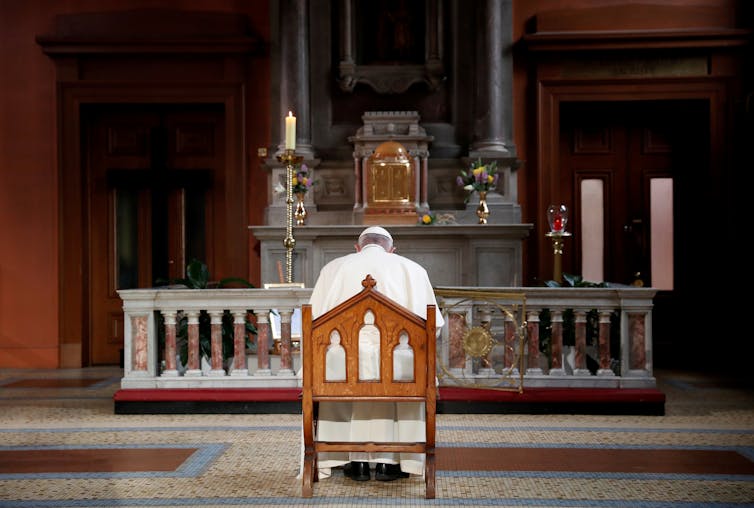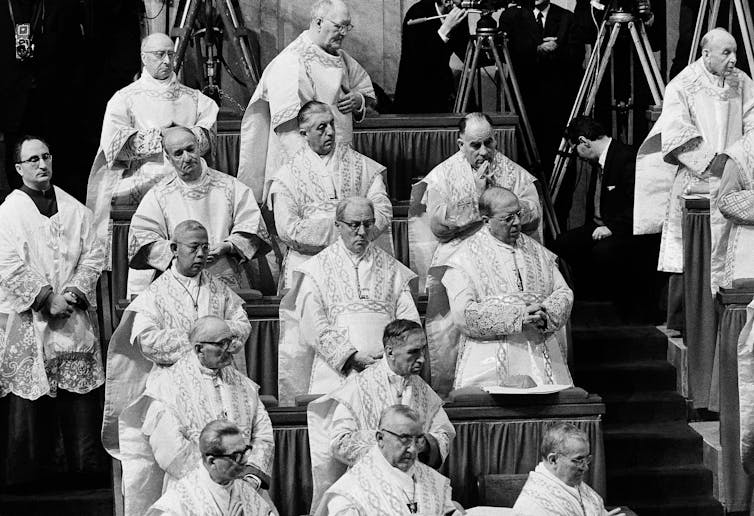The Catholic Church resists change – but Vatican II shows it's possible
- Written by Melissa Wilde, Associate Professor of Sociology, University of Pennsylvania
Pope Francis has asked the heads of every bishops’ conference[1] around the world to gather for a summit in February to discuss the issue of sexual abuse in the church.
Even as the pope takes these steps, debates continue about what he knew[2] and whether there was a better way of dealing[3] with the perpetrators of abuse. There have been many specific recommendations about what Francis could now do to fix the mess the church faces. These include everything from reforming canon law[4] to elevating nuns to the position of Cardinal[5].
Many of these discussions[6] acknowledge that bringing any real change in the Roman Catholic Church is hard, even for a pope. However, as a scholar[7] of religious change, I believe what’s missing in these discussions are examples when significant change was achieved in the church.
The pope’s options
So what exactly can a pope do to change things? First of all, of course, the pope can make many administrative changes. For example, he can modify canon law or the rules that govern the behavior of all priests and members of the hierarchy. He can “reorganize” different Vatican offices, such as the conservative Roman Curia and issue encyclicals[8] to set the tone and tenor of the church.
 Pope Francis prays in St Mary’s Pro Cathedral, Dublin, for victims of abuse by the church.
Stefano Rellandini/Reuters[9]
Pope Francis prays in St Mary’s Pro Cathedral, Dublin, for victims of abuse by the church.
Stefano Rellandini/Reuters[9]
Pope Francis, for example, is well-known for decisions that emphasize simplicity and modesty. For example, after taking office he wore ordinary black shoes to office[10] and chose to ride in an everyday car like a Fiat[11].
But the issue is that the next pope could reverse some or all of these changes. For a change to be permanent, the pope needs to exercise his right to speak infallibly[12] – meaning that what he is saying can never be wrong, and in essence, cannot change.
Speaking infallibly is an incredible burden, in no small part because a pope must do it alone. It has only been done once[13] since papal infallibility was officially declared by the First Vatican Council in 1898. That was in 1950, when Pius XII declared the doctrine of the Assumption of Mary, that she was bodily assumed into heaven upon her death.
What about a council?
But there is a way for a pope to speak authoritatively and with great legitimacy about doctrine: he can call an ecumenical council.[14] In fact, only a pope can call a council, and he does not have to do so in concert with anyone else.
An ecumenical council, by definition, means a gathering of all of the leaders of the world church.
Despite the fact that technically, any pope can call a council anytime, councils are rare events – occurring less than once a century on average. The church’s last council before Vatican II, Vatican I,[15] ended prematurely in 1869 as a result of the Franco-Prussian War and did little of note besides declaring the doctrine of papal infallibility.
Prior to Vatican I, the church had not held a council since the Council of Trent[16] in 1563.
The most recent, and most important, example of change occurring in the Catholic Church is the Second Vatican Council, or Vatican II. In 1998 I started research on Vatican II[17] and gained access to everything from council leaders’ personal correspondence to votes from the Vatican Secret Archive.
I believe, this is a moment to revisit Vatican II and examine what it can tell us about how the church can, and did, renew itself.
Vatican II
When Pope John XXIII called the council in 1958,[18] the world was surprised as were, by all accounts, the Vatican bureaucracy. The council created a “political opportunity” in the church for those who wanted to bring change.
Vatican II was a monumental task. It took four years of preparations[19] and four sessions of debates over three years, between 1962 to 1965.
 Cardinals of the Roman Catholic Church during the closing ceremony of a session of the Second Vatican Council in 1963.
AP Photo[20]
Cardinals of the Roman Catholic Church during the closing ceremony of a session of the Second Vatican Council in 1963.
AP Photo[20]
Almost 3000 bishops, cardinals, heads of religious orders and theologians from all over the world participated in the council. What is noteworthy is that these participants were not members of the Curia, the administrative offices of the Vatican that oversee the day-to-day workings of the church.
These were people usually focused on administering to their local dioceses. But when the opportunity came to change the church, they took it.
The hurdles
The process was difficult and full of set backs. During council preparations and over the course of council itself, the Curia tried to prevent changes. Indeed, deeming the council complete was in and of itself, an ongoing, uncertain and often fraught process.
The initial drafts of statements about church doctrine that the Curia prepared before the council, did nothing other than enumerating errors and reiterating current church doctrine[21]. These, however, were rejected in a dramatic confrontation during the first days of the council.
As I demonstrate in my book on Vatican II[22], such progressive victories were a result of the efforts of a group of bishops who believed in the “doctrine of collegiality.”[23] Approved at Vatican II, this doctrine states that the bishops convening together have the same authority to discuss, debate or change doctrine as the pope. These bishops listened to each other and, most importantly, developed compromise positions that the majority of bishops could support.
Thus, for example, bishops who carried historic animosities toward Protestant missionaries learned how important it was to improve those relationships. My analysis of council votes that I obtained from the Vatican Secret Archive[24] demonstrated that ultimately, a majority of Latin American bishops voted for reforms that helped in better relationships with Protestants.
As a result of many other such dialogues, real changes came about.
The changes from Vatican II
Among the noteworthy ones were those that changed the way the church worshipped. The altar, for example, was turned around to face the people. Mass was changed to be in the vernacular, no longer in Latin. And women no longer had to cover their hair in church.
And these are but the most practical.
Many of the bigger doctrinal changes were those that most Catholics were oblivious to, or knew about only in passing. The biggest of these was the Declaration of Religious Liberty[25].
By declaring that the only just form of government was one under which people were free to worship as they pleased, the church relinquished centuries-old preferential treatment for particular governments. Prior to the declaration, the church had benefited from governments that either repressed other religious organizations[26], or otherwise provided financial or legal support for the Catholic Church.
 Pope Paul VI delivering an address to the United Nations General Assembly in New York, in 1965.
AP Photo[27]
Pope Paul VI delivering an address to the United Nations General Assembly in New York, in 1965.
AP Photo[27]
In doing so the church gained more than it lost. Most of all, it gained legitimacy throughout the globe. Just one indication of this was that during the first papal visit to the United States in 1965, Pope Paul VI was invited to speak at the United Nations[28].
Time for Vatican III?
When Pope John XXIII announced the council[29] in 1958, there was no real crisis in the church. It was, by many measures, a healthy, if ancient institution.
But today, the Catholic Church is facing a crisis: In many places of the world[30], mass attendance is down[31] and a growing number of young Catholics are leaving the church[32].
In addition to these challenges, fewer and fewer men are willing to enter the priesthood[33]. This trend, which began long before the clergy sex abuse scandal, is raising questions around whether the church needs to reconsider its insistence on a male,[34] celibate priesthood[35].
And, of course, there are many other concerns that the church might want to engage with – for example, whether the 98 percent of practicing Catholics[36] who use “artificial means” of contraception – meaning anything other than the rhythm method – are sinners.
It seems possible to me that given the depth and breadth of the issues it is facing, the church needs more than reflection. The church, I would argue, needs change. It needs another council.
References
- ^ heads of every bishops’ conference (cruxnow.com)
- ^ what he knew (www.nationalreview.com)
- ^ whether there was a better way of dealing (www.nytimes.com)
- ^ reforming canon law (theconversation.com)
- ^ to elevating nuns to the position of Cardinal (www.washingtonpost.com)
- ^ Many of these discussions (theconversation.com)
- ^ scholar (scholar.google.com)
- ^ encyclicals (www.papalencyclicals.net)
- ^ Stefano Rellandini/Reuters (pictures.reuters.com)
- ^ ordinary black shoes to office (www.telegraph.co.uk)
- ^ an everyday car like a Fiat (www.washingtonpost.com)
- ^ speak infallibly (www.catholic.com)
- ^ It has only been done once (www.papalencyclicals.net)
- ^ he can call an ecumenical council. (www.newadvent.org)
- ^ Vatican I, (www.newadvent.org)
- ^ Council of Trent (www.newadvent.org)
- ^ research on Vatican II (press.princeton.edu)
- ^ When Pope John XXIII called the council in 1958, (vatican2voice.org)
- ^ It took four years of preparations (www.orbisbooks.com)
- ^ AP Photo (www.apimages.com)
- ^ other than enumerating errors and reiterating current church doctrine (www.unamsanctamcatholicam.com)
- ^ my book on Vatican II (press.princeton.edu)
- ^ who believed in the “doctrine of collegiality.” (www.jstor.org)
- ^ analysis of council votes that I obtained from the Vatican Secret Archive (www.jstor.org)
- ^ Declaration of Religious Liberty (www.vatican.va)
- ^ repressed other religious organizations (eprints.whiterose.ac.uk)
- ^ AP Photo (www.apimages.com)
- ^ Pope Paul VI was invited to speak at the United Nations (w2.vatican.va)
- ^ announced the council (press.princeton.edu)
- ^ In many places of the world (cara.georgetown.edu)
- ^ mass attendance is down (cara.georgetown.edu)
- ^ a growing number of young Catholics are leaving the church (global.oup.com)
- ^ fewer and fewer men are willing to enter the priesthood (onlinelibrary.wiley.com)
- ^ male, (www.womensordination.org)
- ^ celibate priesthood (www.futurechurch.org)
- ^ 98 percent of practicing Catholics (www.americamagazine.org)
Authors: Melissa Wilde, Associate Professor of Sociology, University of Pennsylvania

